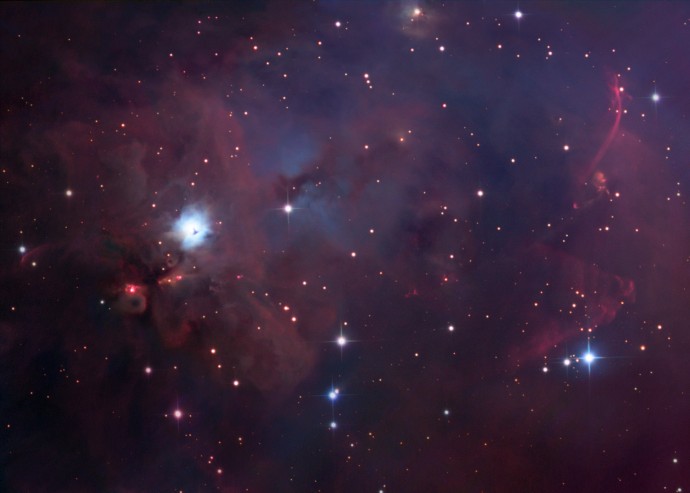Credit & Copyright: Robert Gendler
Explanation:
South
of the large star-forming region known as the
Orion Nebula, lies bright blue reflection nebula
NGC 1999.
The nebula is marked with a dark inverted T-shape at the
lower left in a
broad
cosmic vista that spans over 10 light-years.
The dark shape is a dense gas and dust cloud, or
Bok globule,
seen in silhouette against the bright nebula, and likely
a site of future star formation.
At the edge of the
Orion molecular
cloud complex some 1,500 light-years distant, NGC 1999's
illumination is provided by the
embedded variable star V380 Orionis.
The
region abounds with energetic young stars
producing jets and outflows that create luminous shock waves,
including HH (Herbig-Haro) 1 and 2 just below and left of NGC 1999, and
the apparent cascade
of reddish arcs and bow shocks beginning at the upper right.
The stellar jets and
outflows push through the surrounding
material at speeds of hundreds of kilometers per second.
1999 2000 2001 2002 2003 2004 2005 2006 2007 2008 2009 2010 2011 2012 2013 2014 2015 2016 2017 2018 2019 2020 2021 2022 2023 2024 2025 |
Yanvar' Fevral' Mart Aprel' Mai Iyun' Iyul' Avgust Sentyabr' Oktyabr' Noyabr' Dekabr' |
NASA Web Site Statements, Warnings, and Disclaimers
NASA Official: Jay Norris. Specific rights apply.
A service of: LHEA at NASA / GSFC
& Michigan Tech. U.
|
Publikacii s klyuchevymi slovami:
NGC 1999 - reflection nebula - star formation - otrazhatel'nye tumannosti - zvezdoobrazovanie
Publikacii so slovami: NGC 1999 - reflection nebula - star formation - otrazhatel'nye tumannosti - zvezdoobrazovanie | |
Sm. takzhe:
Vse publikacii na tu zhe temu >> | |
